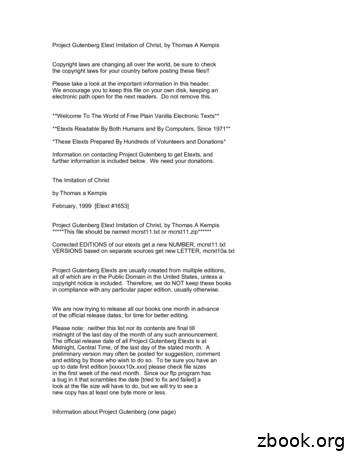New Technology Used To Get Rid Of Unwanted Creatures
New technology used to get rid ofunwanted creaturesBy Associated Press, adapted by Newsela staff on 05.04.17Word Count 788Level 930LThis photo provided by Robots in Service of the Environment, taken April 18, 2017, shows the first day a new robot wasused to hunt dangerous and invasive lionfish in Bermuda. It stuns a lionfish with an electric current and then the fish isvacuumed into a container alive and it can later be sold for food. AP PhotoWASHINGTON, D.C. — Throughout Earth's oceans, forests and grasslands, there areinvaders: animals from distant lands.Invasive species are plants and animals that thrive in areas where they don't naturally live.They are usually brought to new areas by humans, either accidentally or intentionally.No Natural PredatorsSometimes, these invasive species have no natural predators. That means they can simplymultiply and take over their new land, crowding out and, at times, killing native species."Critters are smart — they survive," said biologist Rob "Goose" Gosnell, head of U.S.Department of Agriculture's wildlife services in the U.S. territory of Guam. "Trying tooutsmart them is hard to do."Now, invasive species may have a new enemy: robots.This article is available at 5 reading levels at https://newsela.com.1
New technology is being combined with the old methods to root out unwanted creatures.This is an important development, as invasive species are costly. They cause about 314billion per year in damages in just the United States, United Kingdom, Australia, SouthAfrica, India and Brazil. They cause animals to go extinct.Piero Genovesi is an Italian scientist who helps fight invasive species for an internationalorganization."We have totally new tools that were just unthinkable a few years ago," Genovesi said.The Beautiful And Dangerous LionfishA new underwater robot is targeting the beautiful but dangerous lionfish. The fish hasspread all over the Caribbean, the Gulf of Mexico and up the U.S. East Coast as far northas New York's Long Island, with its venomous spines that are dangerous to touch.Lionfish have no natural predator in the Atlantic. That allows it to devour large amounts ofother fish, including popular fish that humans eat, such as snapper and grouper.The lionfish-fighting robot is the creation of Colin Angle, chief executive officer of IRobot,which makes the Roomba vacuum cleaner. Along with a team, he created a new nonprofitorganization that turns robots into environmental tools.The robot is called Guardian LF1. It uses what Angle says is a gentle shock to stun thelionfish before they are sucked into a tube.During two days of testing in Bermuda recently, the robot caught 15 lionfish. Afterward, thelionfish were handed over to top chefs, who competed to see who could make the bestlionfish dish.Angle is hoping to make the robot more affordable so anyone can use it."What's next?" Angle said. "Our ambition is much larger than lionfish."Brown Tree Snakes Eat Native BirdsA few decades ago, native birds started disappearing from the Pacific island of Guam,baffling scientists. Then they found the culprit: brown tree snakes. The non-native serpentswere eating all the birds and their eggs.The snakes, which live in the trees, had no natural enemies, and just trapping them wasn'tworking, Gosnell said.However, the snakes did have one enemy: acetaminophen, the painkiller drug used inTylenol.So biologists came up with a plan: Use dead mice as bait. Glue a painkiller pill to themice.This article is available at 5 reading levels at https://newsela.com.2
The mice are put in tubes, and 3,000 of them are dropped by a helicopter. The mice popout, and the whole contraption dangles in the trees. It's still experimental but it will soon goto more regular use.Asian CarpThe Asian carp is a fish that's taken over rivers and lakes in the Midwest. To fightthem, U.S. Fish and Wildlife officials are using a specialized boat, nicknamed the MagnaCarpa. It has giant winglike nets that use electric currents as an underwater stun gun toshock the fish, said biologist Emily Pherigo.With more powerful shocks, the fish are killed and float to the surface. In just five minutes,around 500 fish are collected and later turned into fertilizer. This "electro-fishing" waswritten about as a possible conservation technique back in 1933, said biologist WyattDoyle.Wiping Out Wild GoatsOn the Galapagos islands, wild goats were a major problem. In less than five years,scientists wiped out tens of thousands with a special method.Biologist Karl Campbell of the organization Island Conservation introduced specializedfemale goats. They were constantly ready for breeding to lure the male goats into matingwith them. However, these female goats were sterile — that is, they were unable to havebaby goats.Santiago Island, once home to 80,000 goats, is now goat-free and larger Isabella Island isgetting close, he said.And now, Campbell and others are going one step further: tinkering with the genes ofmosquitoes and mice to either make them sterile or only have male offspring. Too manymales would eventually cause a species to die off on an island because there are nofemales to mate with. Campbell cautions that this technology would be difficult to controland use, so it is years away, he says.This article is available at 5 reading levels at https://newsela.com.3
Quiz1What is the purpose of the following selection from the section "The Beautiful And DangerousLionfish"?"What's next?" Angle said. "Our ambition is much larger than lionfish."23(A)to support the idea that the lionfish has already been eliminated(B)to support the idea that lionfish pose a great danger to other fish(C)to show Angle wants to use his technology for other species(D)to show Angle is proud of the success of his new inventionWhat is the author's MAIN purpose in including information about brown tree snakes?(A)to demonstrate invasive species pose a danger to native birds(B)to illustrate another new method for battling invasive species(C)to demonstrate the dedication of biologists battling invasive species(D)to illustrate how the snakes originally became an invasive speciesRead the paragraphs from the section "No Natural Predators."Sometimes, these invasive species have no natural predators. Thatmeans they can simply multiply and take over their new land,crowding out and, at times, killing native species.This is an important development, as invasive species are costly. Theycause about 314 billion per year in damages in just the United States,United Kingdom, Australia, South Africa, India and Brazil. They causeanimals to go extinct.How do these paragraphs MOST help develop the idea that new methods are important forfighting invasive species?(A)by explaining the problem and giving a sense of how serious it is(B)by explaining why the problem keeps happening, despite efforts to solve it(C)by suggesting the problem is the most serious environmental issue faced byseveral countries(D)by suggesting too much money already has been spent trying to fix theproblemThis article is available at 5 reading levels at https://newsela.com.4
4Fill in the blank in the sentence below.In the last section, the author .(A)explains why biologists tried using sterile females instead of other methodsof getting rid of goats(B)suggests the future of battling unwanted species may lie in preventing themfrom breeding(C)outlines the many benefits experienced by islands that have managed toeliminate invasive species(D)argues changing the genes of unwanted animals is a better and kinderstrategy than killing themThis article is available at 5 reading levels at https://newsela.com.5
New technology used to get rid of unwanted creatures This photo provided by Robots in Service of the Environment, taken April 18, 2017, shows the first day a new robot was used to hunt dangerous and invasive lionfish in Bermuda. It stuns a lionfish with an electric current and then the fish is
work/products (Beading, Candles, Carving, Food Products, Soap, Weaving, etc.) ⃝I understand that if my work contains Indigenous visual representation that it is a reflection of the Indigenous culture of my native region. ⃝To the best of my knowledge, my work/products fall within Craft Council standards and expectations with respect to
speakoutTIP The verb get has more than twenty meanings in English! It can mean ‘become’ (get hungry), ‘arrive’ (get home), ‘obtain’ (get a job), ‘buy’ (get a new car) and is in many phrases: get up, get on a plane, get dressed. When you hear or see the word get, think about which meaning it has. Which meaning does get have in these
New York Buffalo 14210 New York Buffalo 14211 New York Buffalo 14212 New York Buffalo 14215 New York Buffalo 14217 New York Buffalo 14218 New York Buffalo 14222 New York Buffalo 14227 New York Burlington Flats 13315 New York Calcium 13616 New York Canajoharie 13317 New York Canaseraga 14822 New York Candor 13743 New York Cape Vincent 13618 New York Carthage 13619 New York Castleton 12033 New .
After you get the access token, use it to verify user roles. This chapter includes the following topics: n Get Your Access Token for the vRealize Automation API n Verify User Roles Get Your Access Token for the vRealize Automation API To get the token used to authenticate your session, you use the Identity Service API to get an API token.
a new technology Xerox’ s digital office platform Start slow (medium returns, medium risk) – Incorporate into one product – Test it, get the bugs out – Incorporate into other products 14 IPPD 3/2/00 New Technology Product Development funnel filter R&D Product concepts for new technology
ftp uiarchive.cso.uiuc.edu login: anonymous password: your@login cd etext/etext90 through /etext96 or cd etext/articles [get suggest gut for more information] dir [to see files] get or mget [to get files. . .set bin for zip files] GET INDEX?00.GUT for a list of books and GET NEW GUT for general information and MGET GUT* for newsletters.
In 2014, the Technology Roadmap development team was formed and used the technology development process In the Spring of 2015, the roadmaps were released to the public of review and comment with the expanded Scope - New: TA15 Aeronautics - 8 new level 2 Technology Areas - 66 new level 3 Technology Areas
Asset management A system that manages and maintains an organization’s assets throughout their lifecycle. Examples of popular systems include spreadsheets and software solutions. Asset management software An application used for the purpose of recording and tracking an asset throughout its lifecycle. In addition, it can provide tools for financial reporting, and often offers the ability to .























